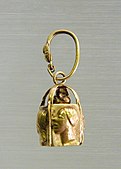Phoenicia
Phoenicia (/fəˈnɪʃə, fəˈniːʃə/),[4] or Phœnicia, was an ancient Semitic thalassocratic civilization originating in the coastal strip of the Levant region of the eastern Mediterranean, primarily located in modern Lebanon.[5][6] The territory of the Phoenicians expanded and contracted throughout history, with the core of their culture stretching from Arwad in modern Syria to Mount Carmel in modern Israel covering the entire coast of modern Lebanon.[7] Beyond their homeland, the Phoenicians extended through trade and colonization throughout the Mediterranean, from Cyprus to the Iberian Peninsula.
For other uses, see Phoenicia (disambiguation).City-states ruled by kings, with varying degrees of oligarchic or plutocratic elements; oligarchic republic in Carthage after c. 480 BC[3]
2500 BC[1]
969 BC
814 BC
64 BC
The Phoenicians directly succeeded the Bronze Age Canaanites, continuing their cultural traditions following the decline of most major cultures in the Late Bronze Age collapse and into the Iron Age without interruption. It is believed that they self-identified as Canaanites and referred to their land as Canaan, indicating a continuous cultural and geographical association.[8] The name Phoenicia is an ancient Greek exonym that did not correspond precisely to a cohesive culture or society as it would have been understood natively.[9] Therefore, the division between Canaanites and Phoenicians around 1200 BC is regarded as a modern and artificial division.[8]
The Phoenicians, known for their prowess in trade, seafaring and navigation, dominated commerce across classical antiquity and developed an expansive maritime trade network lasting over a millennium. This network facilitated cultural exchanges among major cradles of civilization like Greece, Egypt, and Mesopotamia. The Phoenicians established colonies and trading posts across the Mediterranean; Carthage, a settlement in northwest Africa, became a major civilization in its own right in the seventh century BC.
The Phoenicians were organized in city-states, similar to those of ancient Greece, of which the most notable were Tyre, Sidon, and Byblos.[10][11] Each city-state was politically independent, and there is no evidence the Phoenicians viewed themselves as a single nationality.[12] While most city-states were governed by some form of kingship, merchant families likely exercised influence through oligarchies. After reaching its zenith in the ninth century BC, the Phoenician civilization in the eastern Mediterranean gradually declined due to external influences and conquests. Yet, their presence persisted in the central and western Mediterranean until the destruction of Carthage in the mid-second century BC.
The Phoenicians were long considered a lost civilization due to the lack of indigenous written records, and only since the mid-20th century have historians and archaeologists been able to reveal a complex and influential civilization.[13] Their best known legacy is the world's oldest verified alphabet, whose origin was connected to that of the Hebrew script via the Proto-Sinaitic script,[14] and which was transmitted across the Mediterranean and used to develop the Arabic script and Greek alphabet and in turn the Latin and Cyrillic alphabets.[15][16] The Phoenicians are also credited with innovations in shipbuilding, navigation, industry, agriculture, and government. Their international trade network is believed to have fostered the economic, political, and cultural foundations of Classical Western civilization.[17][18]
Etymology[edit]
Being a society of independent city states, the Phoenicians apparently did not have a term to denote the land of Phoenicia as a whole;[19] instead, demonyms were often derived from the name of the city an individual hailed from (e.g., Sidonian for Sidon, Tyrian for Tyre, etc.) If the Phoenicians had an endonym to denote the land overall, some scholars believe that they would have used "Canaan" and therefore referred to themselves as "Canaanites".[20] Krahmalkov reconstructs the Honeyman inscription (dated to c. 900 BC by William F. Albright) as containing a reference to the Phoenician homeland, calling it Pūt (Phoenician: 𐤐𐤕).[21]
The obelisks at Karnak describe a land belonging to the fnḫw, which seems to be the plural form of the Ancient Egyptian word for "carpenter", fnḫ, befitting the crucial station Phoenicia served in the lumber trade of the Levant.[22] The exonym was evidently borrowed into Greek as φοῖνιξ phoînix, which meant variably "Phoenician person", "Tyrian purple, crimson" or "date palm." Homer used it with each of these meanings.[23] The word is already attested in Mycenaean Greek Linear B from the 2nd millennium BC, as po-ni-ki-jo. In those records, it means "crimson" or "palm tree" and does not denote a group of people.[24] The name Phoenicians, like Latin Poenī (adj. poenicus, later pūnicus), comes from Greek Φοινίκη (Phoiníkē). Poenulus, a Latin comedic play written in the early 2nd century BC, appears to preserve a Punic term for "Phoenicians", which may be reconstructed as *Pōnnīm.[25]



